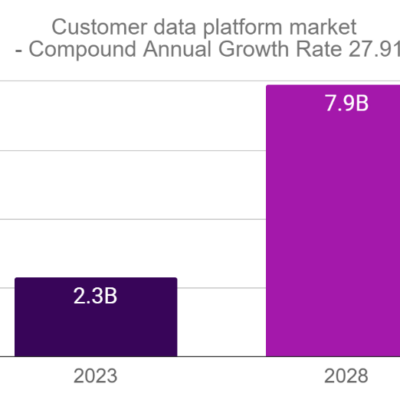With the rise of privacy concerns and the need for marketers to better use their first-party data, Customer Data Platforms (CDPs) have become a hot topic for marketers. As the CDP market has evolved, two main approaches to Customer Data Platforms have developed: Traditional and Composable CDP.
This article summarises the key differences between these two options, highlighting the benefits and considerations of each approach. For a more detailed look at this topic, check out our recent webinar.
We also take a look at how Wondaris, XPON’s proprietary CDP, compares as a hybrid approach to Customer Data Platforms.
A Quick Recap: Why are Customer Data Platforms a hot topic right now?
Several macro trends are driving the rapid adoption and evolution of Customer Data Platforms in the market:
- Privacy regulations like GDPR and CCPA have made it harder for businesses to collect and utilise customer data from various sources. This necessitates a unified platform to manage customer data compliantly.
- Customer expectations are evolving. Today’s consumers crave personalised experiences, and CDPs empower businesses to understand individual customer journeys and deliver targeted messaging.
- Technology changes including the deprecation of third-party cookies and other traditional tracking methods is forcing marketers to find new ways to identify and connect with customers. CDPs offer a solution by creating a persistent, unified customer profile that isn’t reliant on third-party data.
In line with these changes and the growing pressure for marketers to deliver better performance year-on-year, the adoption of Customer Data Platforms is skyrocketing at a Compound Annual Growth Rate of 27.91%, as per Mordor Intelligence’s reports.
Traditional CDP: A Powerful But Rigid Solution
Traditional CDPs offer a solution by creating a unified customer profile.
They act as a central hub that gathers data from various sources and stitches them together to create a single view of each customer.
This allows for powerful marketing tactics like targeted campaigns, personalised recommendations, and improved customer service.
However, traditional CDPs can be expensive and complex to implement.
They often come as a pre-packaged solution, which may not align perfectly with your existing data infrastructure and specific needs.
Imagine buying a pre-built gaming PC – it might be powerful but lacks the flexibility to swap out components for customisation.
Composable CDP: A Flexible and Affordable Alternative
Composable CDPs offer a more modular and accessible approach.
They allow businesses to choose the specific components they need, such as data collection, storage, or activation, and integrate them with their existing tech stack.
This flexibility makes them a more affordable and scalable option for businesses of all sizes.
Think of a composable CDP like building your own PC.
You can choose the components that fit your budget and needs, and swap them out for upgrades later.
Wondaris: A Composable CDP That Bridges the Gap
Wondaris is a Customer Data Platform for marketers and data teams.
Wondaris can be seen as a bridge between traditional and composable CDPs.
It offers a core set of functionalities like data centralisation, audience segmentation, and activation, similar to a traditional CDP.
However, it also embraces the composable approach by allowing users to:
- Enrich data sets with access to multiple 1st and 3rd party enrichment solutions.
- Leverage out-of-the-box machine learning and AI models for immediate use and activation.
- Integrate with established in-house API services or custom third-party data from existing tools you already use.
This hybrid approach allows Wondaris to cater to businesses that might need a more comprehensive solution with pre-built features, while also offering the flexibility to scale and adapt to specific needs through composable elements.
What are the Differences Between a Composable CDP and a Traditional CDP?
Here’s a quick comparison of the features and technical differences between Traditional and Composable CDPs:
| Traditional CDP | Composable CDP | |
|
| Functionality | One size fits all | Individual components can be selected, added, removed. |
Individual components can be selected, added, removed. Focused on specific Use Cases |
| Data Storage | Data stored & duplicated outside of your infrastructure |
Data stored in existing cloud infrastructure. Full data control and ownership. |
Data can be stored in your data infrastructure OR in Wondaris’ infrastructure – owned and controlled by you within your cloud. |
| Data Science and AI | Fixed, ‘black box’ models |
Add and adjust Custom models |
Curated, simple models AND custom modelling capabilities |
| Implementation | Minimum 6 months | 1-6 months | 1-6 months |
| Cost | Full packaged license cost | Cost adjustable based on components required | Cost adjustable based on components required |
How to Decide on the Right CDP for Your Business (Conclusion)
The right CDP for your business depends on your specific needs and budget. Here are some questions to consider:
- What is your current data landscape?
- What are your marketing goals?
- What is your IT expertise?
- What is your budget?
If you’re looking for a powerful and comprehensive solution, a traditional CDP might be a good fit.
However, if you’re looking for a more flexible and affordable option, a composable CDP could be the better choice. Wondaris can be an interesting option if you value both pre-built functionalities and the ability to customise your solution.
Ultimately, the best way to decide is to research your options and consider a free trial or demo to see which CDP best suits your needs.
Learn more via our on-demand webinar: "Beyond the CDP Buzzword"
In this webinar, we explore the true potential of customer data, going beyond the hype of CDPs. We’ll help you determine if a CDP is the right fit for your business, and uncover alternatives to turn your customer data into actionable insights and marketing wins.
